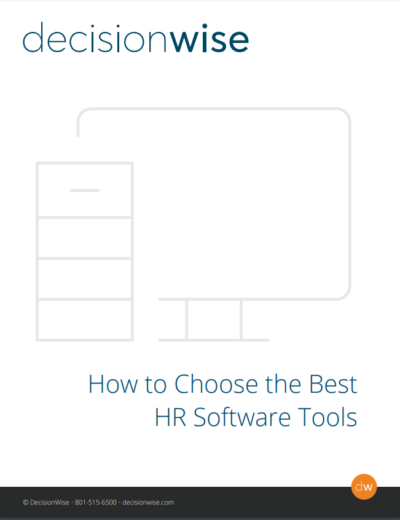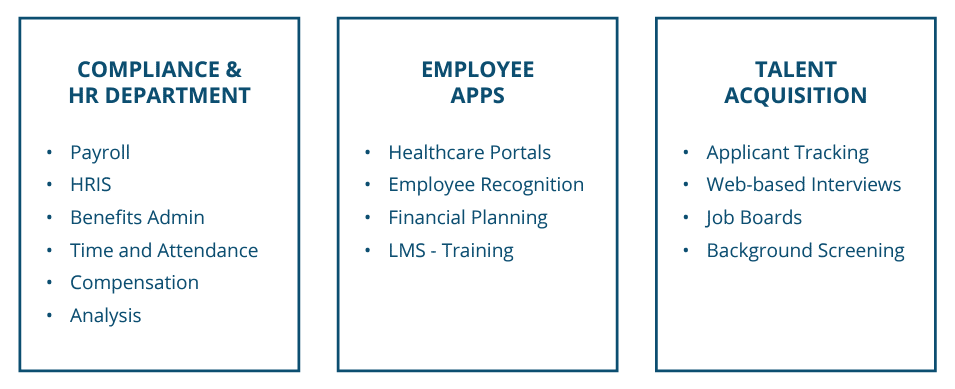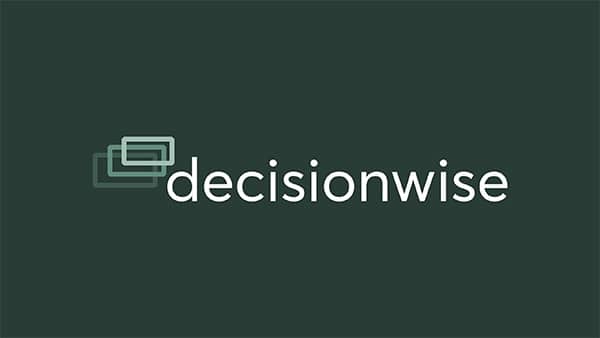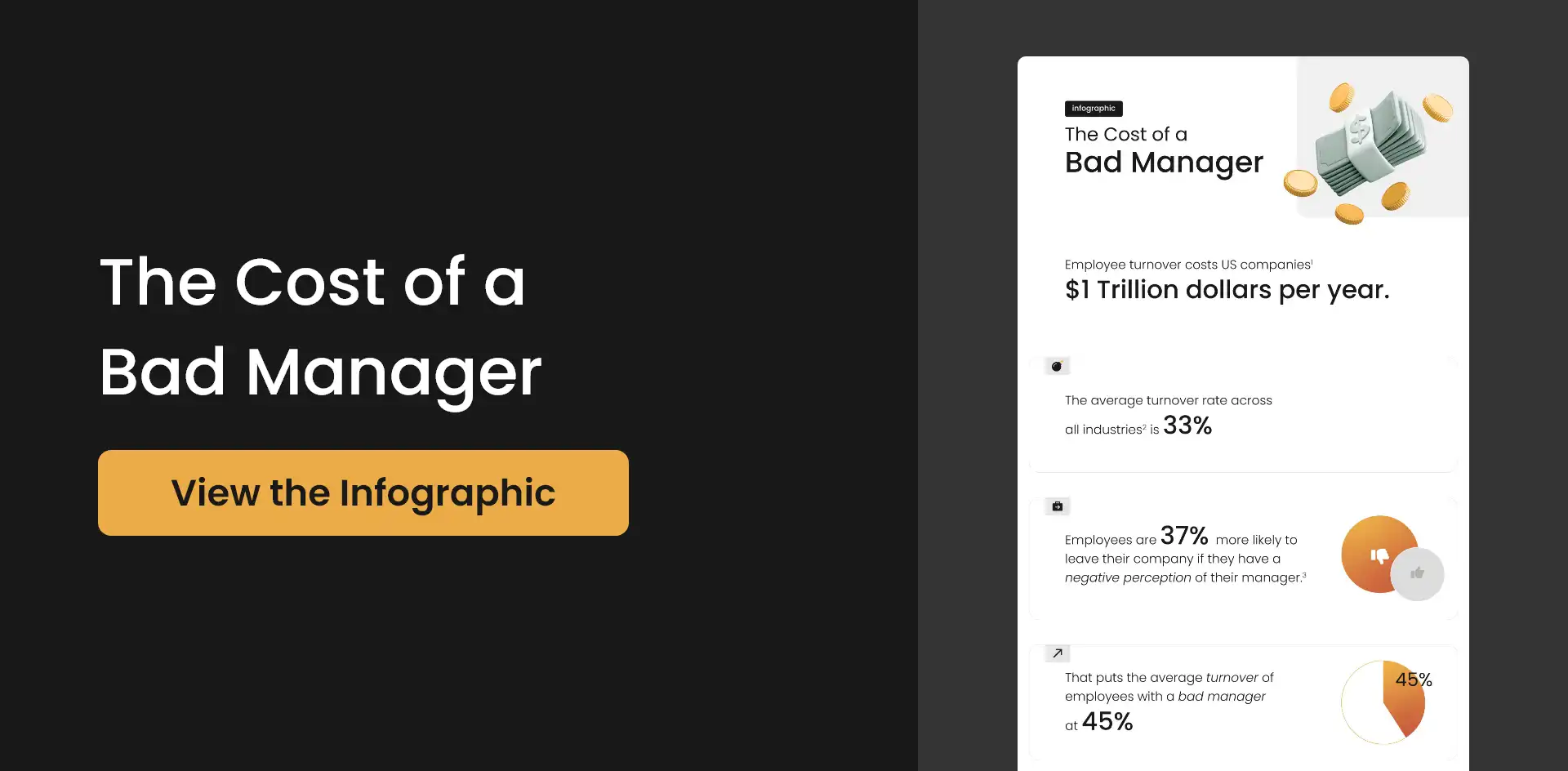
Introduction
HR technology is exploding exponentially. There are more choices than ever to help the HR professional manage what is becoming an increasingly important business function. Whether you are buying a complex HR information system or looking to implement a time and attendance solution, making the right technology choice is critical. We have prepared this guide to assist the HR professional in finding the right HR technology solutions.
Before we dive into the details, however, we need to share a few key insights about technology that we have learned from our own experience and our clients’ successes and missteps.
- Technology cannot solve a business process you do not
- Technology cannot compensate for the lack of
- Technology cannot do the thinking and analysis for you (even in this era of “big data”).
- The more data you collect, the more data you must protect (from unauthorized disclosures – i.e., data breaches).
CASE STUDY:
How to Waste $20,000 a Year
An anecdote from several years ago somewhat illustrates these lessons. We were advising a start-up that was founded by a group of marketing professionals. Admittedly, they didn’t understand much about finance or accounting, but they believed they could “fill” this hole in their executive team by buying a complex enterprise resource planning (ERP) software system. The ERP they purchased was a system that was most often used by organizations that employ tens of thousands of workers, have multiple locations, hundreds of suppliers, intricate operating processes, and complicated inventory systems.
Our brilliant, yet misguided, founders mistakenly believed that the more features their software had, the “smarter” it was. And, “If the big companies use it, then they should be using it too.” Distilled to its essence, they believed there was no need to hire someone with a financial background because the software could do everything for them, plus more. They put their total faith in this ERP.
In the end, they spent nearly $20,000 a year on a solution for a company of fewer than 15 people. And, over the next few years, their company was continually hampered by an accounting system that was too complicated, too expensive, too hard to understand, too hard to use, and it didn’t integrate with any other technology they used in their business. Instead of $20,000 per year, they could have bought QuickBooks for a few hundred dollars and been much better served.
If you ever hear a sales representative tell you that their technology will solve all your problems, our advice is to run; don’t even walk! Technology is merely a tool, and it is only as good as the user who understands the underlying business theories and processes that will be managed by the tool.
GETTING STARTED
This guide’s purpose is to help you not only find and select the right technology based on features and price but also to help you identify and consider these related deployment issues:
- Keeping the process under budget
- Managing the implementation and timeframe
- Minimizing your user’s learning curve
- Addressing scalability – will the technology grow as your organization grows?
- Ensuring integration – will the technology “talk” to your other legacy systems?
- Can the system be customized?
- Does the system come with quality support and timely service?
- Will the implementation require dramatic changes to your business processes?
Tip: Before you buy expensive software, make sure you have looked at your challenges and consider if they might be solved using simpler HR technology solutions or by optimizing your current business processes.
How to Select the Right HR Technology Solution
SAAS VS. ON-PREMISE: IT’S A SECURITY DECISION
SaaS (software as a service) is commonly referred to as cloud computing or cloud services. With a SaaS solution, the software product is accessed through a website, which means the software is not installed or hosted on your organization’s computers but is managed entirely by the software vendor. The vendor does all the work. They manage the updates. They manage the storage and technical requirements.
An on-premise solution is where you buy and install a version of the software on your organization’s computer systems or you hire a data center to host the software application for you. With an on-premise system, you are responsible for either buying a maintenance program or taking care of the maintenance yourself.
Unlike an on-premise solution, a SaaS offering means you do not have to buy special hardware, maintain any hardware, deploy software updates or patches, or otherwise hire expensive IT professionals. And while SaaS systems are much easier to use, there can be a downside – you lose control of how your data is secured. While your data is typically transmitted to the vendor’s servers over the internet through an encrypted channel, you lose complete control of the data once it hits your vendor’s servers. So, buyer beware. You must do your due diligence.
Vs.
If a vendor is competent at data security, then you might realize better security by using a SaaS model. However, if your IT system is unique to an industry, such as healthcare, then your proprietary IT system might be better at protecting your confidential data.
Information security is critical to the HR professional since HR professionals are constantly handling highly-sensitive, personal information. HR departments store everything from an employee’s annual salary to an individual’s performance ratings. Hence, data protection and security may be the most important feature to consider as you explore technology solutions.
Tip: If you select a SaaS model, please ask for documentation showing how they secure and protect your confidential data. You might need this information to prove to others that you are exercising reasonable care in securing your organization’s confidential data. You might also consider asking whether the SaaS provider has a cyber insurance policy that would cover your organization in the event of a data breach.
ADDITIONAL RESOURCES
The following article does an excellent job of considering the pros and cons of SaaS vs. On-Premises deployment:
This link directs you to a cyber security questionnaire that comes with a Creative Commons copyright:
https://digitalimpact.io/document/vendor-cyber-security-questionnaire
This type of security questionnaire will help you navigate the myriad of issues that come with protecting and securing confidential HR information.
What Type of Technology Do do You Need?
In most cases, HR technology is designed to take an existing process and either automate the workflow or improve the way the business process functions. For example, before employee HR self-service portals, the existing process was to provide employees with information through physical documents (printed notices and letters), posters, PDFs, and other electronic files. Now, an employee can log on to a website where they will find all sorts of relevant information about their employment relationship. We call this type of software – Process Improvement Technology.
PROCESS IMPROVEMENT TECHNOLOGY
This can be categorized into the following three subcategories:
- Software for compliance and HR department efficiency
- Employee applications that provide employees with HR information
- Talent acquisition software that helps companies find applicants and move them through the hiring process.
STRATEGIC TECHNOLOGY
The other primary category of HR technology involves breaking new ground by accomplishing new things or completely reinventing how we handle historic HR tasks. For example, data analysis that helps companies predict future workforce shortages is helping the HR function in ways that are new and innovative. This type of technology is best described as Strategic Technology.
While both Process Improvement and Strategic Technologies are exciting and offer significant benefits, Strategic Technology is game-changing because it doesn’t just make the HR function better, it contributes to the organization’s overall success. Strategic Technology provides a return on investment (ROI) that is real and significant. Strategic Technology moves a company forward by solving fundamental business needs, not just handling personnel issues.
Tip: Start with a clear understanding of what you are trying to accomplish and which type of technology will best serve your purpose: Process Improvement vs. Strategic.
CONSIDER YOUR RETURN ON INVESTMENT
A new piece of HR technology should provide your organization with an ROI. In the case of Process Technology, the ROI comes by way of efficiency and cost savings (such as reduced labor costs to fulfill the same responsibilities). In contrast, Strategic Technology’s ROI may be more difficult to label and quantify, but in most instances, Strategic Technology’s ROI will be much more significant, as noted above.
Tip: Make sure you understand the expected ROI and, in a world of limited budgets, you should consider the increased ROI offered by Strategic Technology offerings.
5 Steps to Evaluate Process Improvement Technology
When evaluating Process Improvement Technology, the analysis is linear and straightforward.
1. IDENTIFY THE PROCESS OR WORKFLOW YOU NEED TO IMPROVE
For example, your employees would like a better way to manage their insurance benefits. The best practice is to write your goals down and revise them until you are sure you know exactly what challenges you want to solve.
2. LIST YOUR SPECIFIC REQUIREMENTS
This is where you also address your deployment issues such as customization needs, implementation timetables, etc. You might be tempted to skip steps one and two, but we encourage you to take the time to clarify your thinking by preparing a well-crafted requirements document. Not only will a requirements document hone your analysis, but it will also help drive the process by providing structure. It will also come in handy as you can give this document to potential vendors to help explain what you need.
3. BUILD A LIST OF VENDORS THAT ADDRESS YOUR REQUIREMENTS
Organizations like SHRM publish articles and guides that help HR professionals find and rate software vendors. We have also found Capterra.com to be an excellent way of finding and ranking software vendors in the HR space. A recent search for “benefits administration” on Capterra returned over 100 potential software products.
4. NARROW YOUR LIST DOWN TO TWO OR THREE FINALISTS
This is where you must do some gumshoe work by scheduling software demos, reading reviews, reaching out to colleagues for advice, and otherwise conducting research on what’s available. Most technology providers provide comparison matrices that show how their features compare across the competition.
Tip: Price shouldn’t be the ultimate deciding factor. In many respects, it’s the vendor that helps you understand what you need that might be the best option for your organization.
This is also the time where you consider other factors such as price, responsiveness, support availability, timeliness, quality, reputation, and the long-term viability of the vendor. Final decisions at this stage are also based on rapport with the vendor, consensus among your team, and alignment with your organization’s culture and needs.
At this fourth stage, you will likewise want to address these additional key questions:
- How many successful implementations have the vendor handled before?
- What does the end-user training and documentation look like?
- Who will do the training – internally or by the vendor?
- Do you need IT experts to help with the installation and/or maintenance of the product?
- What business processes will you have to change if any?
- How many customers does the vendor have that are like your organization?
- Does the solution hit the basic requirements and what additional features does it provide that are added benefits?
- How long will it take for you to be fully up and running with this solution?
- How customizable is the solution?
- Is the product easy to use and navigate?
5. DO YOUR DUE DILIGENCE
Ask for and talk to references. Make sure you understand how much the reference spent, in total, to implement the solution. How long did the process take? How distracting was the process and did it require a lot of internal time and effort? Did they experience any bugs? Were their concerns resolved through the vendor’s support function and how long did that take? Would they do anything differently? Finally, has the solution solved the problem it was supposed to address?
Evaluating Strategic Technology
While the evaluation process for Process Improvement Technology is straightforward, understanding how to select the right vendor with Strategic Technology can be quite challenging.
The most difficult part about Strategic Technology is that it often represents discretionary spending of resources, which means you must think about how you spend your resources to get the best results for your organization. You can’t tackle every need, so which are the most important?
We suggest starting with an implementation matrix to inform your analysis.
Once you have taken the time to allocate your challenges within an implementation matrix, then we suggest you prioritize your efforts. Once you are ready to move forward with a strategic solution, the decision-making process should follow the same methodology we described for Process Improvement Technology in the preceding pages.
Conclusion
As an HR professional in the 21st century, your job is to help your organization win. Whether that is winning by increasing sales or winning because your nonprofit is better at meeting its mission and objectives. Nonetheless, the goal is to win.
One way you contribute to this effort is by improving the HR function and by making strategic HR decisions that help the organization find and attract the best talent.
We believe the 21st century will be dominated by organizations that attract, retain, and engage the best employees. We also believe that every important business outcome lies downstream from the experience and engagement of the people who make the organization go.
Our research has also found that you should first start with your employees before you focus on your customers. To create a sustainable, world-class customer experience, an organization must first create a sustainable, world-class Employee Experience (EX). DecisionWise is an EX company that is focused on improving employee engagement and other EX variables. We know that engagement is a fundamental human need. It is a power that resides in most people, waiting to be unlocked. People want to be engaged in what they do. If employers build the foundation, employees will do the rest.
We are biased, and we suggest you spend your strategic dollars focusing on improving employee engagement and your overall Employee Experience. Yet, whatever technology decisions you make, we hope this guide has been useful. Our final piece of advice – take the time to do things right, and you will soon see HR acting as a key driver in your organization’s success.





